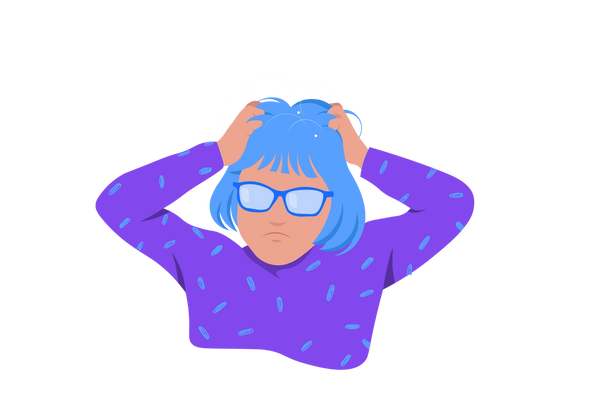Head lice, caused by the parasite, Pediculus humanus capitis, is a condition that causes intense itching of the scalp and predominantly presents in children. Head lice are easily treated with oral or topical medication.
What is head lice?
Summary
Anyone can develop head lice if they have the parasite Pediculus humanus capitis living on their scalp. Head lice is a very common condition. It affects people worldwide, of all socioeconomic backgrounds, and is predominantly seen in children. Symptoms include scalp itchiness, visible marks from itching, and even infection. Head lice are easily treated with topical or oral medications.
Recommended care
You should go to a retail clinic to be treated for lice. Treatment includes using a medicated shampoo, cream rinse, or lotion to kill the lice. Over-the-counter and prescription medications are also available.
Head lice symptoms
Main symptoms
While the symptoms of head lice are not imminently dangerous to your health, they can cause significant discomfort and disrupt daily living.
- Scalp pruritus: Pruritus is the medical term for "itchiness." Itchiness of the scalp is a result of the irritative properties of lice saliva coming into contact with your skin while feeding.
- Excoriations: Excoriations are marks on the skin from repetitive scratching.
- Skin infection: While this symptom of head lice is less common, it is possible to develop a skin infection. Head lice bury into the base of the hair to lay eggs and can create openings in the skin. These openings create an opportunity for bacteria, most commonly the Staph species, to migrate under the skin and produce an infection.
- Difficulty sleeping: As discussed above, head lice can cause intense itchiness on the scalp. This can often lead to difficulty sleeping especially since head lice are more active in the dark.
Diagnosis
Head lice is highly likely if the person has persistent scalp itchiness, especially a child. A diagnosis of head lice is made by directly visualizing live lice. Using a fine-toothed comb provides better visualization of head lice than a regular hairbrush or comb. The nits, or lice eggs, are often firmly attached to the base of the hair.
Head lice causes
Head lice, caused by the parasite Pediculus humanus capitis, can lay eggs and feed in around human hair including the scalp, eyelashes, and eyebrows. There are an estimated six to 12 million cases of head lice each year in children 3-11 years old. Head lice are less commonly seen in African-American children. While the reasoning for this is not entirely clear, it is suggested that the width of Caucasian hair strands are better suited for lice claws than African-American hair. Since lice do not jump or fly, direct contact with the hair of someone carrying lice is usually necessary for transmission. As such, children in close quarters within classrooms are most susceptible to spreading the parasite.
Treatment options and prevention for head lice
Everyone with head lice is recommended to undergo treatment for alleviation of symptoms and containment of the parasite. The presence of live lice should be confirmed prior to treatment as the sole presence of nits, or eggs, does not require further measures.
- Topical pediculicide: Pediculicide is the term used for the chemical used to kill lice. There is a variety of over-the-counter and prescription pediculicides. The pediculicide should be generously applied to wet hair and allowed to sit for at least 10 minutes before removing in the shower. If the topical cream is ineffective in eradicating head lice, you may have lice that are resistant to the particular cream you're using or you may be improperly applying the topical medicine.
- Oral therapies: People with head lice that is refractory to topical treatments may need to take oral anti-parasites.
- School attendance: It is recommended that children with head lice should not be refused daily attendance of school. Precautions should be taken for a child with an active head lice infection to avoid head to head contact.
Prevention
As it is important to not keep children out of school while they have a head lice infection, preventative measures should be taken if a child has a head lice infection. The most important measure is avoiding head-to-head contact. Members of the infected person's household should also be examined for lice infection. The clothes of an infected person should be washed and dried on high heat. Furniture in the household should be vacuumed.
Ready to treat your head lice?
We show you only the best treatments for your condition and symptoms—all vetted by our medical team. And when you’re not sure what’s wrong, Buoy can guide you in the right direction.See all treatment optionsWhen to seek further consultation for head lice
If you have persistent scalp itchiness, you should seek further consultation from your physician. If you try to treat head lice infections with over-the-counter measures and continue to experience symptoms, you should consult your physician as you may have an infection resistant to certain medications.
Questions your doctor may ask to determine head lice
- How badly is your scalp itching?
- Do you know anyone around you that has lice?
- Do you feel like something is crawling on your head?
- Is your scalp itchiness getting better or worse?
- Do you live in a crowded space in close proximity of other people?
Self-diagnose with our free Buoy Assistant if you answer yes on any of these questions.
Was this article helpful?
